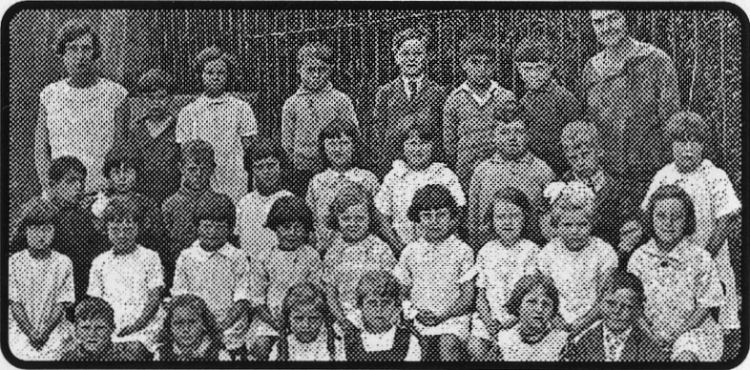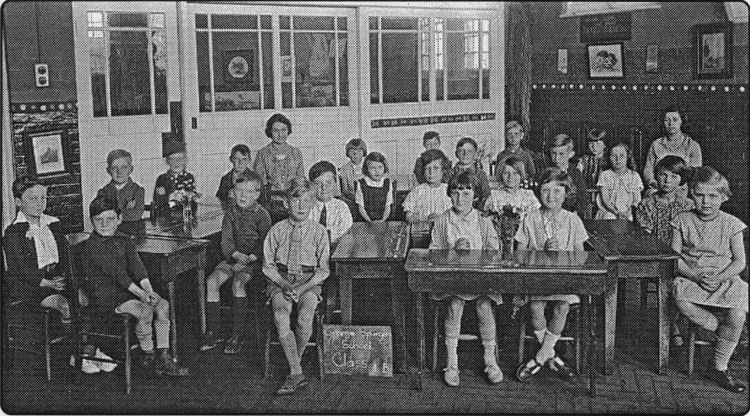
Published 12 September 2002

Its full
marks
to Lcs!
MEMORIES reader Leslie Bradfield was quick off the mark to respond to a
reader's plea for an old George Spurgen School photograph. He nearly beat me
to it in reaching the Herald office, last Thursday morning!
Veteran Les, who went to George Spurgen School himself, from the age of five
to 14, had to apologise for not having the exact picture that Mrs Ivy Marsh
{nee Marsh) was looking for, but he said, it is the right year, 1929 and he
thought Ivy and other readers would be interested to see it.
Les, who lent me another school picture for 1926, lives in Dolphins Road,
Folkestone. He says he remembers all the teachers and classrooms of the old
school.
The primary school headmistress in 1926 and 1929, he said, was Miss Powell,
while the teacher in his 1926 photo, was Miss Goodridge.
A recent Memories photograph from
Folkestonian David Sheppard, working in Saudi Arabia, of a local cub scouts
group was of special interest to John Oliver who was a member of the group
which, he says, was the 22nd pack attached to the parish church, not the
25th.
John was able to name the adult leaders from right to left, as Mike Johnson,
Sheila Marwood, Daphne Kitchen, Percy Port, of Elham, district commissioner,
with Colin Johnson, assistant county commissioner, squatting in front.
John believes the photo dates from 1952-53 and may have been taken after the
scouts won the Whittingstall Trophy.
Stars at Rhodes Minnis
Do you remember the old days of motorcycle grass track racing in East Kent
at hillside circuits like Lydden, Rhodes Minnis and elsewhere? The events
became a proving ground for more than a few riders who went on to become
world champions.
Many grass track racers went on to ride professionally in road racing and on
the world speedway race circuits.
Enthusiasts tended to follow the fortunes of particular riders with a
certain style, or because they were fascinated by their home-built specials
and the kind of engines and sometimes non-standard fuel that they used.
Local enthusiast Pete Hogben, who used to write race reports for the
Folkestone Herald once said that with costly fuels or additives like nitro
methane you could say the racing machines ran on liquid dynamite!
I remember that once I became mobile, as a cub reporter with the Dover
Express, on my humble 250cc BSA C11 motorcycle, I would visit a variety of
circuits all over Kent, but Rhodes Minnis and Lydden were particular
favourites.
I followed the ups and downs of local stars like Monty Banks, of Capel, and
later his two sons, with their garage at Deal.
Only the other day he reminded me the old oval Rhodes Minnis circuit, on a
local farmer's land, used to attract crowds of 8,000 and more who came to
watch stars from far and wide. Several of them became world champions.
And now, hopefully once a year. International Grand Slam meetings at Rhodes
Minnis are to be held, organised by the Astra Grasstrack Club
which used to promote motor racing at Lydden, spearheaded by the late Bill
Chesson.
A number of the old veterans will be guests at the first "revival" Grand
Slam meeting, which is on Sunday, September 15, with the promise of a star
entry - the event has attracted both national and world champion riders of
solo machines and sidecar outfits.
And riders and supporters are making a weekend of it. On the Saturday there
is to be an arena trials display followed by a disco.
The Grand Slam meetings of the 1960s were second only to the national
championships.
Although it was a grass circuit, on a long straight there was no lack of
speed, figures of over 90mph being claimed.
Names of the star riders bring back happy
memories for many; names like Nigel Bocock, Reg Luckhurst, Jackie Sewell,
Tony Back, "Spud" Tatum, Alf Hagon, Chris Stewart, Wigan wonder-boy David
Baybutt, Derek Andrews, Lew Coffin, Sid Jarvis, young Graham Banks, Stan
Luck and many others, as well as up-and-coming youngsters like Peter
Chittenden,
And that's without naming the sidecar racers and their somewhat daredevil
passengers, who without doubt thrilled the crowds!
Their names included Webster, Wicken, Lofthouse, Papworth, Duke, Dutton,
McBeth, "Weedy," Coleman, Nourish and Adams.
Sadly, I believe racing came to end at Rhodes Minnis when the land had to be
sold, after the owner died. The sale took place in July 1970, Monty Banks
reminded me.
ANGELIC-looking faces at one of Folkestone's schools, in 1929. "George
Spurgen School, Class 1! is chalked on the slate standing on the floor in
front of some of the old desks. The photo was shown to me by Memories reader
Leslie Bradfield, who also has the 1926 classroom picture, top right. He is
standing 4th from the right in the back row.

 |
Decorated floats fun at town’s annual Regatta
A Q/\0 FOLKESTONE Rowing Club was due 19U& to stage a procession of
decorated boats early in September, with prizes offered to visitors,
residents and boatmen, in co-operation with the Regatta Committee.
Police Court Missionary at Folkestone Mr Bickers was busy in the Kent
hopfields entertaining and lecturing with the aid of a lantern slide
projector. The Herald backed an appeal for a harmonium to help with
mission sing-songs. Local part-time soldiers of the 1st Volunteer
Battalion of the Buffs supplied a particularly large contingent of men
for first aid duty at the Coronation of King Edward VII. The ancient
craft of hand^loom weaving was undergoing a revival in East Kent. It was
reported 23 looms were at work at the Canterbury Weavers, alongside the
river in the High Street, which opened free to visitors. The Herald,
looking back 100 years, wrote of John Bailey's 'machine,' carrier's cart
or 'omnibus' as it was later called, which made a return trip to Deal in
a day, on Tuesdays or Thursdays, and likewise a return trip to
Canterbury on a Saturday, but made overnight stops in winter.
|
Heraldharks back to time people were put in stocks
«« q r<J THE SPECTACLE of 55 hoses shoot-ing water high over the inner
harbour captivated thousands of visitors 50 years ago, as firemen, in an
exercise, dealt with a series of 'incidents.' With the Queen looking
forward to her coronation, in 1953, the Herald was harking back to
Folkestone in the days of Queen Elizabeth 1 st. It was then but a small
fishing village of a few hundred people. The council of the time fixed a
penalty of two old pennies for each hog that was allowed to stray onto
the Stade unattended and John Corke's wife paid about five shillings for
giving lodgings to the town's first schoolmaster. But less than nine
shillings was paid as a 'reward' to the Queen’s Players who had visited
the port. Painting of the Town Hall cost £1 plus three pennies for
kindling for a fire on which the painter heated up his colours. John
Holler was sentenced to spend three hours in the stocks for failing to
tell anyone he knew Robert Burden's wife had arranged to meet another
man, Robert Gottle, at Sugar Loaf Hill and eloped. Margaret Browne,
widow of Thomas, was banished from the town for seven years for
"unlawful practices" and told she would be ‘ if she came within seven
miles.
|
Children preferred Sidney Street school to holidays!
Hi QO7THE OLD Sidney Street School was JL«7<£ * evidently a popular
place 75 years ago for it was often said that the infants there would
rather go to school than have a holiday! This was recalled at a parents'
evening when headmistress Miss Powell and her dedicated staff were given
a pat on the back for their work with the children and the school was
presented with a gramophone by the Folkestone Education Committee, in
recognition of their efforts. Herald writer Felix sang the praises of
the 800ft high Highcliffe Tea Gardens, at the Valiant Sailor,: which had
the advantage of a five-minute bus service leaving the old Cooperative
Stores in Dover Road for Dover; and was being advertised as one of
Folkestone's premier attractions 75 years ago. The Herald published an
interesting photograph of six coxswains of Kentish lifeboats, including
W.H. Baker, of Folkestone and H Griggs, junior, of Hythe, and other
lifeboat-men, aboard the Margate lifeboat Lady Southborough during the
trip back to the Kent coast after attending the unveiling of a memorial
in Calais to French lifeboatmen.
|
Tourism vital to future of Shepway says councillor
<| Q'V^SHEPWAY was said to be one of the / I nicest places to stay in
and had guest houses with 2.500 beds and yet a meeting in Folkestone was
told that it wasn't clear whether the district had decided to be a
tourist centre or wanted to be another Manchester or Birmingham.
Councillor Philip Carter warned that there were some in high places who
did not want tourism, "but without it you are not going to achieve
anything - that's where the money comes from," he warned. A visitor
wrote to the Herald complaining that bathers were not being given
adequate warning of dangerous swimming conditions when thesea was
choppy. She said she had several times seen people swimming when there
were heavy breakers and considerable under-tow on the steeply shelving
beach, but there was no red flag flying. If the council could not afford
the wages of a man to put up the flag as he did in her youth, there
could at least be better warning notices. A reader was bemoaning the
fact people in Folkestone were complacent in concluding that you had to
put up with the menace of seagulls in town if you lived by the sea. By
contrast Dover people got the council to remove the eaas from the nests. |
|



